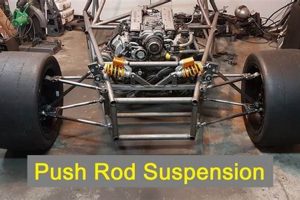A self-assembled, motorized vehicle, frequently a small, open-wheeled racer, is the focus of this exploration. Often constructed from readily available parts or repurposed materials, these machines represent a hands-on approach to engineering and recreation. A common example involves utilizing a small gasoline engine, a frame fabricated from metal tubing, and wheels salvaged from other vehicles to create a functional, albeit simple, racing machine.
The appeal of this endeavor lies in several factors. It offers practical experience in mechanics, fabrication, and problem-solving. Historically, such projects have fostered innovation and resourcefulness, allowing individuals to create customized transportation solutions within budget constraints. Furthermore, the satisfaction derived from building a working machine from scratch is a significant motivator.
The subsequent sections will delve into the various aspects of constructing such a vehicle, including frame design considerations, engine selection processes, steering and braking system implementations, and safety protocols to ensure responsible operation.
Essential Construction Guidance
The following provides essential guidance for successful construction, focusing on critical areas to ensure performance and safety. Attention to these details can significantly impact the final outcome.
Tip 1: Frame Integrity: The frame constitutes the foundation. Employ robust welding techniques and select materials appropriate for the anticipated loads. Inadequate welds or weak materials compromise structural integrity and safety.
Tip 2: Engine Mounting Security: Secure the engine firmly to the frame. Vibration can loosen bolts and cause damage. Consider using vibration-dampening mounts to minimize stress on both the engine and the frame.
Tip 3: Steering System Precision: Ensure the steering system operates smoothly and accurately. Slop or excessive play in the linkages affects handling and control. Regular lubrication and adjustment are essential.
Tip 4: Braking System Reliability: Implement a reliable braking system capable of providing adequate stopping power. Disc brakes generally offer superior performance compared to drum brakes, especially in wet conditions. Inspect brake lines and pads frequently.
Tip 5: Wheel Alignment Accuracy: Precisely align the wheels to optimize handling and tire wear. Incorrect alignment results in uneven tire wear, reduced stability, and increased steering effort. A professional alignment is recommended.
Tip 6: Throttle Cable Function: The throttle cable must actuate smoothly and return reliably. A sticking throttle can lead to dangerous situations. Inspect the cable for fraying or kinks, and lubricate regularly.
Tip 7: Safety Equipment Prioritization: Incorporate essential safety features, including a roll cage, seat belt, and kill switch. These features mitigate risks in the event of an accident.
Adherence to these guidelines promotes a safer and more rewarding construction experience. Diligence and attention to detail contribute significantly to the overall quality and performance of the finished vehicle.
The subsequent section will discuss testing and fine-tuning procedures to optimize performance and handling characteristics.
1. Frame Welding Strength
Frame welding strength is a paramount factor in the successful construction of any self-assembled motorized vehicle. The integrity of the frame directly correlates with the overall safety and performance of the machine, making welding a non-negotiable aspect of the build process.
- Material Selection and Weld Compatibility
The choice of materials for the frame dictates the welding process and the required filler material. Dissimilar metals may require specialized welding techniques to ensure a strong, corrosion-resistant joint. For example, mixing high carbon steel with mild steel requires specific welding rods and procedures to prevent cracking and ensure structural integrity. Mismatched materials and inadequate welding can lead to catastrophic failures under stress.
- Weld Penetration and Fusion
Adequate weld penetration is essential for a strong joint. Insufficient penetration leaves the weld susceptible to cracking and failure under load. Achieving proper fusion, where the weld metal merges seamlessly with the base metal, requires precise control of heat input, welding speed, and filler material deposition. A common error is surface welding, where the weld merely sits on top of the base metal without properly fusing to it, creating a weak point in the frame.
- Weld Inspection and Quality Control
Visual inspection is the first line of defense against weld defects. Look for porosity, cracks, undercut, and incomplete fusion. More advanced non-destructive testing methods, such as dye penetrant inspection or ultrasonic testing, can reveal subsurface flaws that are not visible to the naked eye. Implementing a rigorous quality control process ensures that all welds meet the required strength and integrity standards.
- Impact of Welding Technique on Frame Rigidity
The welding technique employed influences the overall rigidity of the frame. Overheating the base metal can lead to distortion and weakening of the surrounding material. Stitch welding, a technique where short welds are strategically placed along the joint, can minimize heat input and distortion compared to continuous welding. Proper sequencing of welds is also crucial to distribute stress and prevent warping of the frame.
The correlation between welding strength and the overall safety and longevity of a self-constructed motorized vehicle is undeniable. Compromising on weld quality risks structural failure and potential injury. Therefore, mastering appropriate welding techniques, selecting compatible materials, and implementing thorough inspection procedures are essential for responsible and successful vehicle construction.
2. Engine Power Selection
Engine power selection is a pivotal decision point in the design and construction of a self-assembled motorized vehicle. The chosen engine’s output characteristics directly influence vehicle performance, handling, and overall safety.
- Torque Characteristics and Drivability
Torque, the rotational force produced by the engine, dictates the vehicle’s acceleration and its ability to overcome inclines. An engine with high low-end torque provides strong acceleration from a standstill and is advantageous for navigating varied terrain. Conversely, an engine lacking sufficient torque may struggle on hills or require frequent gear changes, reducing drivability. For example, a small displacement engine with limited torque may be unsuitable for a kart intended for off-road use, while a larger, m
ore torquey engine provides better performance in those conditions. - Power-to-Weight Ratio Considerations
The power-to-weight ratio, a measure of engine power relative to the vehicle’s mass, is a critical determinant of performance. A higher power-to-weight ratio results in quicker acceleration and higher top speeds. However, excessive power in a lightweight vehicle can compromise handling and stability, potentially leading to dangerous situations. Carefully calculating the power-to-weight ratio is essential to ensure a balance between performance and control. A kart with an excessively powerful engine, but a weak chassis, might become unstable at high speeds.
- Engine Reliability and Maintenance
Engine reliability and ease of maintenance are practical considerations. A high-performance engine may offer superior power output but may also require more frequent and complex maintenance. Choosing an engine known for its durability and simple design can minimize downtime and reduce maintenance costs. For example, a readily available, mass-produced engine with ample spare parts may be a more practical choice than a rare or highly specialized engine, even if the latter offers slightly better performance.
- Fuel Efficiency and Operating Costs
Fuel efficiency directly impacts the operating costs of the vehicle. An engine with high fuel consumption increases the expense of operation. Considering the intended use of the vehicle and the availability and cost of fuel is important in making an informed engine selection. A kart intended for recreational use on private property may not prioritize fuel efficiency as highly as one used for longer trips or competitive events, where fuel costs can become a significant factor.
The selection of an engine for a self-constructed motorized vehicle necessitates a comprehensive evaluation of performance characteristics, reliability, and operating costs. Balancing these factors ensures a machine that is both enjoyable and safe to operate. Prioritizing a well-matched engine to the vehicle design will result in optimal balance in the final product.
3. Steering System Precision
In the realm of self-constructed motorized vehicles, steering system precision is a critical determinant of operational safety and handling characteristics. The direct correlation between steering accuracy and vehicle controllability necessitates meticulous design and construction. A lack of precision translates into delayed or inconsistent responses to driver input, potentially leading to loss of control. Consider a scenario where a vehicle intended for off-road use possesses excessive play in the steering linkages; this imprecision manifests as difficulty maintaining a straight trajectory on uneven terrain, increasing the risk of rollovers or collisions with obstacles. Consequently, precise steering mechanisms are indispensable for ensuring safe and predictable vehicle behavior.
The implementation of a precise steering system involves several key factors. Proper selection and installation of steering components, such as tie rods, steering knuckles, and steering boxes, are crucial. These components must exhibit minimal backlash and operate with smooth articulation to minimize lag between driver input and wheel movement. Furthermore, correct steering geometry, including parameters such as caster, camber, and toe, must be accurately set and maintained to optimize handling and tire wear. Inadequate steering geometry can result in excessive steering effort, instability at higher speeds, and uneven tire wear, all of which compromise the vehicle’s handling characteristics and safety.
In summary, steering system precision is not merely a desirable attribute but a fundamental requirement for the safe and effective operation of self-constructed motorized vehicles. Its influence on vehicle controllability necessitates diligent attention to design, component selection, and installation practices. A commitment to precision in steering system construction mitigates risks, enhances handling, and ultimately contributes to a safer and more enjoyable driving experience. The understanding of its importance connects directly to responsible building.
4. Braking mechanism reliability
Braking mechanism reliability is a critical safety consideration in the design and construction of self-assembled motorized vehicles. The ability to predictably and effectively decelerate or stop a vehicle is paramount to preventing accidents and ensuring operator safety. Compromises in braking system design or construction directly translate to increased risk of collisions and potential injury.
- Hydraulic System Integrity
Hydraulic braking systems, commonly found in these vehicles, rely on the integrity of their fluid lines, master cylinder, and wheel cylinders or calipers. Leaks, blockages, or component failures can compromise the system’s ability to generate and transmit the force necessary for braking. For instance, a ruptured brake line resulting from improper routing or material fatigue can lead to a complete loss of braking power, requiring immediate corrective action. The absence of regular maintenance or inspection can exacerbate these issues, further reducing reliability.
- Friction Material Condition
The condition of the friction material, specifically brake pads or shoes, directly impacts braking performance. Worn or contaminated friction material reduces the coefficient of friction between the braking surfaces, increasing stopping distances. Regular inspection of brake pad thickness and replacement when necessary is essential to maintain optimal braking effectiveness. Neglecting this aspect can lead to metal-to-metal contact, damaging rotors or drums and further compromising system reliability.
- Mechanical Linkage Security
Vehicles employing mechanically actuated braking systems depend on the integrity of linkages, levers, and cables. Slack, corrosion, or component breakage can reduce the effectiveness of the braking system and introduce unpredictable response characteristics. A loose or binding cable, for example, may result in uneven braking force distribution or a delayed response, making it difficult to control the vehicle during emergency stops. Proper adjustment and lubrication are crucial for ensuring consistent and reliable operation.
- System Redundancy Considerations
Implementing redundancy in the braking system enhances overall reliability. This can include incorporating a dual-circuit hydraulic system, where the failure of one circuit does not completely eliminate braking ability. Alternatively, a mechanically actuated emergency brake can provide a secondary means of stopping the vehicle in the event of a primary system failure. The inclusion of such redundancy features significantly increases the margin of safety and reduces the risk of catastrophic braking failures.
The reliability of the braking mechanism in self-assembled motorized vehicles is intrinsically linked to operator safety. A proactive approach to system design, component selection, and ongoing maintenance is essential for mitigating the inherent risks associated with vehicular operation. The principles of robust engineering and diligent inspection serve as cornerstones in the pursuit of dependable braking performanc
e, ultimately contributing to a safer operating environment.
5. Occupant safety features
In self-constructed motorized vehicles, occupant safety features represent a critical layer of protection against potential injury during operation. The inherent nature of these machines, often built without the rigorous safety testing mandated for commercially manufactured vehicles, underscores the importance of integrating robust safety measures. The absence of such features can lead to severe consequences in the event of an accident, highlighting a clear cause-and-effect relationship between their presence or absence and the severity of potential outcomes. For example, a roll cage constructed from adequately strong materials and properly welded to the frame can prevent crushing injuries during a rollover, whereas its absence exposes the occupant to significant risk of head and torso trauma.
The implementation of occupant safety features extends beyond mere inclusion of components. It requires a thorough understanding of impact forces, energy dissipation principles, and materials science. A simple seat belt, while seemingly basic, must be properly anchored to the frame to effectively restrain the occupant during a collision. Similarly, a helmet, chosen to meet recognized safety standards, must be worn and secured correctly to provide adequate protection. Furthermore, the placement of sharp or protruding objects within the occupant compartment should be minimized to reduce the likelihood of secondary injuries during an impact. Consideration of these details transforms safety features from theoretical additions to practical safeguards.
The integration of occupant safety features into the design and construction process represents a responsible approach to building self-constructed motorized vehicles. While challenges exist in replicating the comprehensive safety testing of commercial vehicles, adherence to established safety principles, careful material selection, and meticulous construction techniques can significantly enhance occupant protection. The understanding and prioritization of these features are not merely recommendations but essential components of a safe and enjoyable building experience.
Frequently Asked Questions about Self-Assembled Motorized Vehicles
The following section addresses common inquiries and concerns regarding the design, construction, and operation of self-assembled motorized vehicles.
Question 1: What are the fundamental legal considerations regarding the operation of a “diy kart” on public roads?
The operation of a self-assembled motorized vehicle on public roads is subject to stringent regulations varying by jurisdiction. It is imperative to consult local laws concerning vehicle registration, safety inspections, and equipment requirements. Failure to comply may result in fines, vehicle impoundment, and legal liability in the event of an accident.
Question 2: What is the recommended method for determining the appropriate frame geometry for a self-built kart intended for off-road use?
Frame geometry for off-road self-built karts should prioritize stability and ground clearance. A wider wheelbase enhances stability on uneven terrain, while increased ground clearance reduces the risk of obstacles impacting the undercarriage. Researching established off-road vehicle designs and adapting relevant geometric principles is advisable.
Question 3: What types of welding processes are suitable for frame construction, and what are the inherent risks associated with each?
Shielded Metal Arc Welding (SMAW), Gas Metal Arc Welding (GMAW), and Gas Tungsten Arc Welding (GTAW) are commonly employed for frame construction. SMAW, while versatile, is prone to slag inclusions. GMAW offers faster welding speeds but may produce excessive spatter. GTAW provides the highest weld quality but is more time-consuming. Inadequate shielding gas or improper electrode selection can lead to weakened welds.
Question 4: What are the key factors to consider when selecting a braking system for a “diy kart” intended for competitive racing?
Braking system selection for competitive racing demands consideration of stopping power, heat dissipation, and weight. Disc brakes generally offer superior performance compared to drum brakes, especially at high speeds. The braking system should be sized appropriately for the vehicle’s weight and expected operating conditions. Additionally, minimizing unsprung weight is crucial for optimizing handling.
Question 5: What are the minimum recommended safety features to incorporate into a “diy kart,” and what standards should those features meet?
Minimum safety features include a roll cage constructed from steel tubing meeting recognized standards (e.g., SAE 4130), a five-point harness conforming to SFI specifications, and a fire suppression system certified to meet FIA standards. Helmets should meet DOT or Snell ratings. These standards ensure a minimum level of protection in the event of an accident.
Question 6: What procedures should be followed for testing and fine-tuning the handling characteristics of a completed “diy kart?”
Testing and fine-tuning should commence in a controlled environment. Begin with low-speed maneuvers to assess steering response and braking effectiveness. Gradually increase speed while monitoring stability and handling characteristics. Adjustments to suspension settings, tire pressures, and steering geometry may be necessary to optimize performance and ensure safe operation.
In summary, the construction of a self-assembled motorized vehicle requires careful consideration of legal regulations, design principles, safety standards, and testing protocols. Adherence to these guidelines promotes a safer and more rewarding building experience.
The subsequent section will delve into advanced topics related to performance optimization and customization of these vehicles.
Conclusion
The preceding exploration of the “diy kart” has illuminated critical aspects of its design, construction, and operation. From frame integrity and engine selection to steering precision, braking reliability, and occupant safety, each element demands meticulous attention to detail. The legal and ethical implications surrounding these self-assembled vehicles necessitate diligent adherence to regulations and a commitment to responsible building practices.
As interest in personalized transportation solutions continues to evolve, the future of the “diy kart” lies in the hands of informed and conscientious builders. Prioritizing safety, embracing innovation, and upholding ethical standards will ensure the continued viability and responsible evolution of this unique form of motorized vehicle construction.







